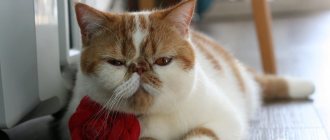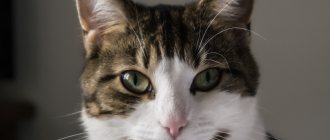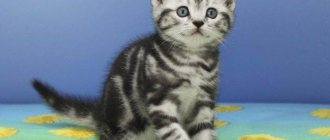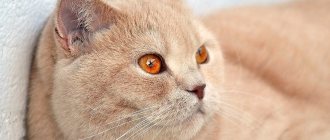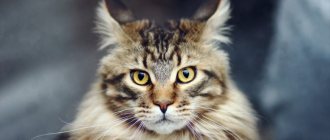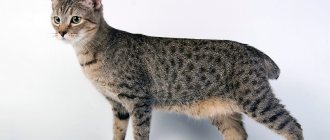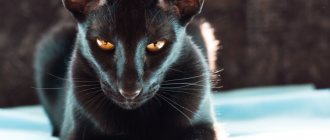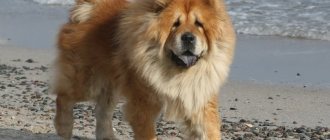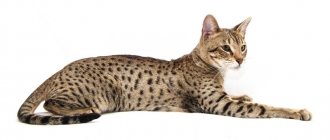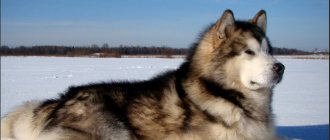Character
The exotic cat has a very docile and friendly character.
Exotics simply cannot imagine their life without a person, so they become extremely attached to their owner. When separated for a long time, they really become very sad and very bored. Cats of this breed are ideal pets - they have developed intelligence and memory, they are very quiet and do not have the habit of hooliganism. Exotics are very curious and love active games with their owner. They are also very trainable, so standard training in the form of litter box training or a ban on scratching with their claws on furniture and walls with exotic animals will be very quick and easy. Many note that exotics are very good with children, so this will be relevant for families with small children.
Japanese Snoopy cats (sometimes mistakenly called Chinese cats) are peaceful and inquisitive. They always choose one owner for themselves, whom they consider the leader. Exotics are literally on the heels of their chosen owner; their loyalty is often compared to that of a dog.
Snoopy the kitten is wary of strangers and never immediately comes into contact with them. If the owner leaves the pet alone at home, he needs to provide several toys so that the cat does not get bored. Snoopy desperately needs human interaction and physical contact.
- I'm a bee!..
Occasionally, exotics can begin active play activities: run around the room and carry objects that are freely available. If someone is looking at the cat, then such a performance can last a long time.
Cats of the Snoopy breed have high intelligence and good memory. That is why they subtly sense the emotional state of the owner. Accustoming an exotic cat to a litter box, a scratching post, and to respond to a nickname will not be difficult.
https://www.youtube.com/watch?v=_QkjtCrZbYw
These exotic animals are excellent travelers. They can easily endure long journeys.
We invite you to read: Description of the breed and character of the Shar Pei
What breed is the cat named Snoopy?
A kitten named Snoopy became famous around the globe in 2011, when his owner began posting photos of her pet on the Internet. A huge number of people liked this animal, which looked just like a plush one. Many considered this cat to be a representative of some new Japanese breed, despite the fact that Snoopy was born and lived in China. In fact, the breed to which he belonged appeared back in the sixties of the last century in the United States. And she is called an exotic shorthair cat. Abbreviated as exotic. And after 2011, these cats got another, unofficial name - Snoopy.
The appearance of exotic cats is the result of a mistake by breeders. Several US breeders planned to diversify the possible colors of American Shorthair cats and make them stronger and more resilient. To do this, they were crossed with the Persians. Later, Burmese and Russian Blue cats were added to this mixture in order to improve the quality of the coat.
Chinese kitten Snoopy
But the result was not at all what the breeders expected. The cats turned out to look more like Persians, only with an even more upturned nose. But the quality of the wool was truly excellent. The first exotic kittens were obtained in 1967.
For a very long time, felinologists did not want to recognize these animals as a separate breed. They were officially registered only in the nineties of the last century. But the standard was finally formed only in 2000.
You can often hear Snoopy called “exotic Persians.” This is no coincidence, because exotic cats took a lot from their ancestors. But still, this name is incorrect, since exotics are a separate independent breed and have a large number of differences from Persian cats.
As a rule, exotic cats are quite large. Their weight on average reaches 7 kilograms. But the breed standard does not establish specific sizes for a given animal, therefore both larger and smaller animals may well be considered representatives of this breed. Of course, if they have all the signs of Snoopy:
| Sign | Description |
| Body type | The body is of medium size and has very strong bones. Its shape is close to square |
| Limbs | Medium in length. Strong and sturdy |
| Tail | Short, proportional in size to the body |
| Neck | Short but powerful |
| Head | Size - medium, shape - round |
| Muzzle | Flattened, with a pronounced and very sharp stop - the transition from the forehead to the nose. Cheeks drooping |
| Ears | Small, widely spaced. The ends are rounded, slightly inclined downwards |
| Eyes | Large, round, located at a great distance from each other |
| Wool | Short and very soft (both undercoat and guard hairs), feels like plush. The undercoat is thick |
| Color | The breed standard allows all possible colors |
The character of an exotic cat is calm, balanced, and phlegmatic. She is not very fond of outdoor games, preferring instead to sit on a person's lap. The last Snoopy is very devoted. They require a lot of attention and do not tolerate loneliness well. They are distinguished by patience and an almost complete absence of aggression. It is very difficult to get rid of such an animal. This feature makes the exotic a suitable pet for families with children. He will also get along with other pets, be they dogs, birds, cats or rodents.
Exotics are very loyal to their owner. Once you become attached to one person, it is very difficult to get used to others. They tolerate various trips quite well if they are accompanied by their owner. Therefore, it is advisable to take such a cat with you on any trip, if there is even the slightest opportunity to do so.
History of the development of the exotic breed: key dates
In the early 1960s, a group of scientific breeders decided to experiment and try to cross short-haired cats with the Persian breed. They wanted a healthier cat with a strong skeleton and noble appearance. This is how the short-haired “relative” of the Persians appeared - the exotic Snoopy.
The famous cat Snoopy, after whom the breed is named
1966 was a landmark year for the breed; the Cat Fanciers' Association (CFA) officially recognized it as a separate group.
In 1967, the Snoopy standard was registered, to which minor changes were made in 1973.
In 1975, crossing representatives of the breed was prohibited; mating was allowed only with Persian or American smooth-haired cats, but in 1980 the latter were also prohibited from crossing with Snoopy.
In 1990, the standards of Snoopy and the Persians were recognized as identical.
Additional Information! The Snoopy breed was initially considered a big failure. They did not want to separate it into a separate group, since it was believed that it was a variety of the Persian breed, but with short fur.
Exotic cat - price and how to buy it correctly
The price of a cat depends, first of all, on the purpose for which you are buying it. The most expensive kittens for breeding are breeding and show classes. Depending on the rarity of the color and compliance with the standard, the price for such cats can reach up to 1000 USD. The price is also affected by the number of papers accompanying the kitten and the vaccinations that were given to it.
The problem when choosing show kittens is that they acquire a typical dense coat only at 4 months, and before that the length of their fur can only be determined in a prediction format. Although experienced breeders are quite confident in determining the length of the coat at the age of 8 - 9 weeks.
Pet kittens that are intended for castration, but can participate in exhibitions in their category, cost 10 - 15 thousand rubles, and rejected cats with disqualifying defects will cost even less. They can be very cute, for example, with their tongue constantly sticking out due to a malocclusion.
The most important thing is to buy a healthy cat, or a relatively healthy one. Kittens raised in nurseries that responsibly select sires, as a rule, do not carry hereditary diseases
But given the range of genetic problems of exotics, it is risky to purchase a pet from someone else. Although the price for such kittens is minimal: 3 – 10 thousand rubles, or even “in good hands”.
Kittens are purchased at the age of at least 2.5, and preferably 3 months, when the cat weans them. At this age, their immunity is quite strong, and their psyche is set up for an independent lifestyle
When choosing a kitten, you should not be touched, but pay special attention to the bite, the condition of the eyes and nose, mobility and the manifestation of a keen interest in what is happening.
It’s so good that there are cats for every taste: resembling a wild animal and a teddy bear, fluffy and hairless, miniature and huge. It’s so good that there is a breed of exotic cat that appeals to a peaceful soul yearning for love, silence and comfort. And how good it is that interest in this breed is growing - it means there are many such souls in the world.
Castration and sterilization
If the cat is not intended for breeding, it is better to spay or sterilize the animal. During castration, the reproductive organs are removed, in whole or in part. A cat's testicles are removed; in a cat with partial castration, only the ovaries; in a complete castration, the uterus is removed. However, recently, partial castration has been offered less and less due to the risk of developing pathologies in the uterus that began before castration. During sterilization, nothing is removed, but the spermatic cords of the cat or the ducts of the cat are ligated.
In this case, the animals retain the ability to mate without producing offspring. Typically, sterilization is practiced in nurseries.
Experienced veterinarians and breeders recommend castrating exotic cats at the age of 7–9 months.
Caring for your pet after surgery
Caring for a cat or an exotic breed is no different from caring for animals of other breeds. On the first day after surgery, it is necessary to monitor the pet’s condition, provide it with warmth, peace and absence of contact with other animals, if any.
The animal after surgery requires special attention
During the postoperative period, the animal experiences:
- Dry eyes. When anesthesia is administered, cats' eyes do not close; they remain open. During the operation, the veterinarian closes the animal's eyelids from time to time so that the conjunctiva is moistened with tears. Until the cat recovers from anesthesia, the owner will have to do this. In order to properly care for your pet's eyes, you need to buy tetracycline eye ointment or antiseptic drops. After the pet has recovered from anesthesia, there is no need to close his eyes; he will do this on his own. There are times when an animal lies for a long time with its eyes open, then it is necessary to drip saline solution into the eyes, this will save them from dryness.
- Low body temperature. The usual cat temperature is 37.5 – 39.0 degrees Celsius. In the postoperative period, the temperature can drop to 36.5 - 37.0 degrees. The cat should be placed on a warm bedding and covered with a warm blanket. In extreme cases, you can warm it with a heating pad. To normalize blood circulation, you need to rub the ears and paws.
- Unsteady gait. This is due to the relaxation of muscles during the application of anesthesia. On the first day, you should better monitor your pet so that he does not climb to any height, otherwise he may not be able to hold on and fall.
- At first, the cat needs painkillers. If your pet is silent, this does not mean that he does not feel pain. Most animals silently endure pain. They completely refuse food and are in a motionless position. Their pupils, as a rule, are dilated and concentrated. The gaze is fixed on one point.
The owner's actions in the postoperative period:
- Every day it is necessary to examine the groin area and check for bleeding;
- In order for the sutures to heal better, they are treated with hydrogen peroxide and brilliant green twice a day; you can also lubricate the suture area with Levomekol ointment;
- During the rehabilitation period, the cat must be wearing a collar that will prevent the animal from licking the wound, as this can lead to the sutures coming apart and, accordingly, infection;
- The rehabilitation period is easier in the winter; if the operation was performed in the summer, then a five-day course of antibiotic therapy may be needed - it is better to be on the safe side than to treat the resulting infection later.
Snoopy cat care and nutrition
Such unusual cats are exotic Snoopy and require special care. Unlike other short-haired animals, they require careful grooming.
Although Snoopy's fur is short, it is no less than that of the Persians. Plus there is a thick undercoat underneath. To avoid tangles, you need to comb out the “cubs” at least twice a week.
It is recommended to immediately instill in kittens a love of the bath, because these animals require monthly bathing. But the face needs to be cleaned with a damp cloth every day.
If cats develop tear tracks, they should be removed with special means. Also, you need to carefully monitor the teeth of the “buns”, buy cleaning bones, and from time to time look into the animal’s mouth.
Unfortunately, the breed is susceptible to genetic diseases. Cats may develop breathing problems, lacrimation, or, conversely, obstruction of the tear duct. Preventative visits to the veterinary clinic are recommended in order to promptly diagnose the disease and begin treatment.
When it comes to food, exotics are usually unpretentious. Owners should opt for balanced cat food or high-quality “natural” cat food. The diet must include:
- Dairy products. Kefir, fermented baked milk, sour cream. At the same time, fresh fermented milk can cause stomach upset, so it is worth giving the products on the second or third day from the date of manufacture.
- Meat.
- Vegetables and cereals.
- Vitamins for cats.
Babies up to three months of age are fed 6 times a day, kittens up to six months old - 4 times, and adult Snoopy - morning and evening.
In addition, it is important to leave a bowl of clean drinking water in a place accessible to the cat.
Features of care
Caring for Snoopies compares favorably with caring for their Persian ancestors. There, the main work falls on maintaining the long coat, which exotics lack. A couple of weekly approaches with a comb are enough to remove lost hair and stimulate the correct functioning of the root bulbs. The rest of the time, cats act independently - lick their thick fur coat and keep it clean.
Liquid begins to ooze out of the tear ducts of little Snoopies during any temperature changes or during mild colds, and the area around the eyes is lined with dirty, untidy glasses. If neglected, this leads to changes in coat color and even hair loss. The processing can be carried out by any suitable means.
Exotics take a long time to mature. Sexual maturity is formed by 10–12 months, and they gain full physical condition only by 2 years. It is often said about Snoopy that the period of childhood play for these decorative cats has been prolonged, and therefore they remain with the character of small kittens for the rest of their lives.
Choosing a kitten
Most often, people fall in love with an exotic baby at first sight, so they don’t experience any particular difficulties with the choice. Since childhood, exotic kittens have been distinguished by their cuteness and resemblance to a plush toy.
However, you should pay attention to the animal’s documents and its pedigree. It is advisable to purchase a kitten from well-known nurseries or from trusted breeders to be sure of the health and breed of your pet.
Not very honest breeders sell British dogs under the guise of exotics, often mixed with Persians. However, such a British exotic will not be a representative of the breed. The first show disqualifies the animal due to non-compliance with the standard.
There are also crossbreeds such as the exotic fold, when a Scottish fold is crossed with an exotic shorthair cat. Today, crossing exotics with any other breeds is strictly prohibited, so buying such a kitten is a serious risk. In addition to the unpredictable appearance, the pet can get serious health problems.
Nicknames for cats of exotic boys are often selected based on their behavior, character or appearance. An excellent name for a calm and noble pet would be Athos or Guy; for a robber and restless pet, Porthos or Ralph would be more suitable. Exotic babes are often given names that indicate their cute appearance - Plusha, Sunny, Mila.
How much does an exotic cat cost?
The price for a kitten of an exotic breed is determined by its pedigree, class, and nursery. The average cost of a pet-class baby is $300. And for those who want to know how much an exotic show-class cat costs, breeders answer - from 8 thousand rubles.
Names for exotic cats may correspond to their original name "Sterling". That's why babies are often called Pound or Buck.
Owners of exotic cat breeds unanimously consider their pets to be the best domestic cats. These funny animals with excellent character bring only positive emotions to their owners.
https://101kote.ru/porody-koshek/ekzoticheskaya-korotkosherstnaya-koshka.htmlhttps://lapkins.ru/cat/ekzoticheskaya-koshka/https://tvoikoshki.ru/porody/ekzoticheskaya-koshka/
Basics of proper nutrition for exotics
From infancy, exotics must receive a sufficient amount of vitamins and minerals so that the body develops correctly and the coat is smooth, healthy and silky. Only the owner decides what kind of food will be - natural, home-cooked or commercial from the store.
How to properly organize natural nutrition
Owners of exotic cats who decide to feed their pets natural food must remember that it is forbidden to give food from the human table to the animal. No matter how pleadingly the exotic eyes look at the owner during dinner, you need to be adamant.
You can't overfeed cats. A fat exotic will not lose its external charm, but there will be problems with health.
The diet that a cat requires for the proper development of the body may seem rather meager and unappetizing to some owners, but deviation from it can cause irreparable harm to the pet’s health.
Table 3. Products that should be present in the daily diet of an exotic cat\
| Product | Variations | How to give and what it affects |
| Dietary meat | Veal, beef, rabbit meat | It is given raw, pre-frozen and thawed so that the low temperature kills all parasites. It is necessary to give sirloin parts, as they contain animal protein required for the comprehensive development of all body systems. |
| Poultry is lean | Turkey, chicken | These products are not suitable for daily nutrition, as they do not contain enough amino acids. Chicken or turkey should be given 1-2 times a week. |
| Animal entrails | Lungs, beef kidneys, chicken hearts and ventricles | Wild cats eat small animals along with internal organs, which contain many trace elements. At home, you can fill this gap by using offal, previously scalded with boiling water. |
| Fish, cleaned of bones and scales | Ocean fish – cod, herring, mackerel | Fish is fed once a week; too frequent “fish days” can become an impetus for the development of kidney disease. River fish should not be given at all, as infection with parasites may occur. |
| Dairy products | Low-fat cottage cheese, yogurt, kefir | Fermented milk products must be given to exotics daily. It supplies the cat's body with calcium and helps the normal functioning of the gastrointestinal tract. |
At least 75% of a cat's daily diet should consist of meat, fish and offal. You also need to add a side dish that is mixed with the main dish - it can be porridge, fresh vegetables, herbs, sometimes you can add egg yolk. There is no need to feed your pet tenderloin every day, as such a diet will negatively affect your pet’s health.
Exotic cats are far from omnivores: they will only eat what they like.
Digestion of dairy products is best in kittens; in adult cats, flatulence is possible. Products that were produced 2-3 days before the date of use are best absorbed.
How to choose the right industrial feed
In order to feel good and develop normally, your pet must receive all the products necessary for the full functioning of the body:
- vitamins and microelements;
- amino acids;
- saturated fats.
Dry food classes: pros and cons
All these elements are found in vegetables, meat, fish and cottage cheese. However, if the owner does not have time to prepare food specifically for the pet, you can choose a more practical option: buying dry food
It is important to consider that the popular inexpensive canned food sold in supermarkets has a bad effect on your pet’s body. It contains a lot of salt and seasonings, which significantly reduces the lifespan of a cat.
You should pay attention to balanced dry food that is sold in pet stores. When choosing food, you need to pay attention to reviews from breeders and the composition, which should list all the necessary microelements
Some felines like dry food more than fresh meat or fish.
Health of the snoopy-cat breed
The breed of exotic smooth-haired cat was bred artificially, which means a high probability of genetic diseases in these purrs. At the same time, the life expectancy of Snoopy cats is quite respectable - up to 14–16 years with good care and careful attention to health.
Snoopy cats are susceptible to genetic diseases
Ailments that most often overtake exotic cats:
- deformation of the teeth and jaws - the specific structure of the skull provokes protrusion of the lower jaw (due to which the pet cannot eat normally) or a change in the position of the teeth (requires surgical intervention);
- increased tearfulness - associated with deformation of the tear ducts against the background of irregular structure of the muzzle and nose;
- chronic disease of the sinuses - due to Snoopy’s small nose, the sinuses are often clogged, where microbes accumulate and inflammation begins (if the animal begins to sniffle, the veterinarian will prescribe suitable drops);
- kidney disease (polycystic disease) - symptoms appear in adult animals and are expressed in loss of body weight, lack of appetite, constant vomiting (it is impossible to cure a pet, but a special diet and therapeutic procedures will help alleviate the condition);
- difficulty breathing (an extreme case is brachycephalic airway obstruction syndrome) - associated with a short nasal passage in which bacteria accumulate (a runny nose appears, colds are common) or a genetic disease (the structure of the trachea and larynx changes, can be treated surgically);
- hypertrophic cardiomyopathy - an incurable disease characterized by lethargy and refusal to eat, increased fatigue (males get sick more often than females), maintenance therapy is prescribed;
- dental diseases (gingivitis, tartar) - you can recognize it by the pet’s bad breath and behavior (Snoopy will refuse to eat), the doctor will prescribe a diet and prescribe suitable medications to relieve inflammation.
Health problems and life expectancy
Turkish Angora (cat): description of the breed and character
Like other cat breeds artificially bred through crossbreeding, Snoopy the cat is susceptible to genetic diseases.
Ailments and illnesses that can occur in Snoopy the cat:
- jaw deformation;
- increased tearing;
- chronic nasal disease;
- kidney dysfunction;
- hypertrophic cardiomyopathy.
With careful care and timely vaccinations, representatives of the breed live for about 15 years.
Character of the breed
The exotic is a harmonious creature even in the sense that his character completely matches his appearance. The Snoopy cat has a very friendly disposition. In adults, it may seem somewhat phlegmatic, but kittens are usually very playful, cheerful and active. Moreover, a cat can maintain such curiosity and activity until old age (and representatives of this breed live on average 15 years). These are not at all aggressive creatures. They are very trainable, so there are no problems with them.
Usually he chooses one person in the family, and he recognizes him as the owner and loves him unconditionally. Such cats also treat other family members quite kindly.
Representatives of this breed do not like loneliness. Therefore, if you have to leave your pet for a long time, you need to make sure that he has enough household toys to keep himself occupied.
Snoopy cats are a breed that is distinguished by high intelligence and good memory. But talkativeness is not in their nature. Even the kitten will not beg for food and will not greet its owner out loud, although it is usually immensely happy to see its owner. The voice of an exotic can be heard extremely rarely, especially since such animals are usually quite serene.
They arrange noisy games only if they have caring spectators. Then they can have very active romp and races, especially if there is a small child in the house who can keep them company.
Reviews
Somehow we came across these cats on the Internet. For a long time they could not recognize the breed. and then we came across Snoopy-babe :-) and it turned out that they were exotic. Found an advertisement. We went, looked and of course immediately fell in love. We have a cat, his name is Syoma, he is 4 months old. There are no special problems with nutrition: he loves fish very much, strangely, but mostly river fish. although they gave me sea food. Everything is boiled and not salted. How often do we give the little one baby food (mix it with porridge), but he only eats beef and doesn’t eat pork at all. He uses the litter tray to go to the toilet and eats a little litter. In general, he likes to lie around where it’s dirty, in shoes, near a trash can, I don’t know what attracts him so much there. Ours has a dual character: he is a kind, sweet, but also an evil rodent. He can bask endlessly, purr, sit in his arms, and can literally after a while begin to scratch and rush around the apartment. But despite all this, we love him very much :-) all the relatives and friends who have seen him say that he is the cutest cat they have ever seen.
I had been dreaming about something exotic for a long time, and finally my boyfriend gave it to me as a gift. Such a tiny little eye, huge round head, big little tail with an antenna, a fluffy one. But as he began to grow up, from about 3 months he began to throw himself on his legs from behind, biting his hands with terrible force, it would seem that he was still small, but how much strength he had. He is constantly scratched and refuses to go to the litter box. He already has 3 trays, at first they thought maybe they bought a small one and bought a larger one, then they thought they bought high sides with low ones. No, he still walks next to the tray. But these are still flowers, he began to walk on the table and climbs and lies like a sphinx and it’s a pity to beat him, like a child, you scold him, he purses his ears, understands, but still climbs. Now he is 7 months old and all hell has begun...we haven’t been able to sleep for two weeks now. HE starts screaming so heart-rendingly from one in the morning that until everyone gets up, he doesn’t calm down, he calls to play like that. But the interesting thing is that before that there was not a sound from him, just purr purr and that’s it. Even if you step on his tail, he is silent, but now he is screaming. so he has to play and run after him in the middle of the night. and how he sheds, just what kind of food I didn’t feed him and tried Proplan and Royal Canin and Hills. Hills actually made him feel sick. nothing helps, the fur flies in clumps even if you shave it. The veterinarian prescribed us vitamins, which also had zero effect. but a dream.
From early childhood I dreamed of an exotic kitten. And now, finally, our family has been replenished with a wonderful plush miracle. Almost a year ago I bought a kitten named Camry from a specialized nursery. He came to me as soon as he was 3 months old. The kitten has already received all the necessary vaccinations and is accustomed to a tray and scratching post. His parents are representatives of famous breeding lines of America, Russia, Spain and Ukraine. He is absolutely unperturbed - only when he hears that a fly is flying in the room, the hunter in him wakes up. Camry has never scratched me - he always hugs me with his soft paws. With this cat, scratches on your hands are completely unrealistic. He does not like loneliness - he tries to spend as much time as possible in the company of a person. Camry even learned the word "eat" - as soon as someone walks into the kitchen and says the magic word, he immediately runs to his feeders. He gives his voice extremely rarely - only if he thinks that they forgot to feed him on time. Also, we do not have situations of jumping on the closet and riding on curtains - Camrick can only climb somewhere if he is carried there in the arms! He doesn’t mark the apartment or other people’s slippers when guests arrive—he always greets them and watches them in a friendly manner. This is the ideal cat, but only if it is purebred! Be very careful when purchasing, a real exotic will cost about a thousand euros. To avoid getting a bully at home and being bitterly disappointed, trust only nurseries with a name and a good reputation! My furry miracle is already 2.5 years old. Now I can’t even imagine how I ever lived without a cat!
Cats of the Snoopy breed are cute domestic creatures, one look at which will make you want to smile and forget about all your problems.
An adorable cat named Snoopy has taken the internet by storm with his stunning photos. It's hard to believe that this is not a plush toy, but a real live cat. After such a stir, many began to wonder what breed Snoopy the cat is, how to care for him and how much he costs. This will also be discussed in this article.
Exotic colors - features of the fur of Snoopy cats
The genes of the Persian cat, inherent in exotics, made the pets' fur long - the length of the pile reaches 5 centimeters. The thick undercoat gives exotics a characteristic plush effect, which is one of the main requirements for the “purity” of the breed.
The coat colors of exotic cats have a palette that fully matches the colors of their Persian ancestors. The most popular colors among breeders include:
- solid - solid color. It has shades of black, white, red, gray and all pastel colors. Characterized by the solid absence of any spots and stripes;
- smoky - smoky color. The fibers are dark at the ends, the undercoat is light. Smoky shades include shades of black, chocolate, ash;
- turty – tortoiseshell. Often, tortoiseshell color appears as a combination of black and red, with the addition of white and sometimes lilac. What is noteworthy: representatives of the tortoiseshell color are mostly females (like other cat breeds);
- tabby - striped pattern, brindle, pattern on the forehead in the form of the letter “M”;
- chinchillas - cats have coats with a golden or silver tint;
- color point - coat color in the style of the Siamese breed - dark ears, muzzle and limbs, the rest of the coat is cream-colored.
Representatives of pure colors are rare; More often than not, in exotics one color predominates, with elements of another.
Snoopy cat character
These are extremely friendly and peace-loving creatures who gladly take part in the life of the family. Snoopy cats are distinguished by their curiosity and calm disposition, and are easy to train. The one who feeds and cares for the purr most often is chosen as a pet. Other domestic exotics are treated with due respect and never show aggression.
Snoopy cats are one of the kindest and most affectionate purrs.
The breed cannot be called lazy either - the seals are ready to run and jump until they are old. Therefore, it is better to stock up on a large variety of cat toys and accessories so that your pet does not get bored while the owner is busy.
At the same time, these smart girls will not cause chaos in their home if they are in a bad mood or have too much fun.
Table: pros and cons of Snoopy cat character
| Positive traits | Negative qualities |
| Playfulness | Do not tolerate loneliness well |
| Lack of aggression | Strongly attached to people |
| High intelligence | Excessive gullibility |
Since Snoopy cats have a gentle and easy-going disposition, they easily get along with other pets and are happy to be in the hands of small children. If there are strangers in the house, the exotic will take an interest in the guests and go to a secluded place to sleep.
Raising a cute pet
The exotic breed is a sociable breed, so it is perfect for large families. However, like any pet, a cat needs education.
The exotic strictly follows the rules in the house. This is an incredibly clean animal, spending a third of the day grooming itself. There are no difficulties in accustoming the animal to the tray. The only thing that will allow a pet to break the law will be an unpleasant odor from the cat litter. The tray must be clean and free of foreign odors.
Like any cat, an exotic cat will definitely try to sharpen its claws on furniture or wallpaper. You can avoid this by using a scratching post, which you can purchase or make yourself. You can also help your pet maintain its manicure by trimming its claws with special scissors once a week.
The animal fulfills all commands and requirements quickly and with pleasure. The cat understands intonation quickly and is even able to learn simple commands. By placing your voice correctly, you won’t have to repeat the requirement twice. If a cat is told not to climb on a cabinet, he will not dare to disobey the order.
Despite their easy-going nature, exotics are also distinguished by their intrigues, which they like to play up to overly strict owners. Cats sense aggression and anger towards themselves instantly. For the same reason, they do not deny themselves the pleasure of tearing their owner’s leather jacket or getting the carpet wet.
If an exotic acted meanly, you should not punish him. It is better to reconsider your attitude towards the animal and not get involved in a war.
Like any predator, your pet will need a secluded place where he can sleep and take a break from the hustle and bustle of home. Any box without a strong odor or a special basket will be suitable as a “nest”. The cat will rest there during the day. At night, exotic cats, like Persians, prefer to sleep next to their “loved” person.
Appearance
After the official recognition of the breed, the American Exotic underwent some changes in its appearance. He became more like a Persian, and a distinctive feature was added - a clearly defined sharp transition from the forehead to the nose, the so-called “stop”. This characteristic feature gave rise to some cat lovers calling him an Exotic Persian. However, this is fundamentally wrong. Exotics are a completely new breed in which the shorthair gene is firmly attached. At the same time, in order to improve exotics, it is still allowed to use Persians, and the standards of these breeds have become almost identical for some time.
Generally accepted standard
So, let's find out what characteristic features exotic cats and cats have. The characteristics of this breed have the following distinctive features:
- a rounded head with a flattened muzzle;
- short, snub nose with a “stop”;
- full cheeks;
- small ears with a slope;
- large round eyes;
- thick, strong paws;
- plush, soft short coat with a thick undercoat;
- strong bones and a small, fluffy tail.
Cats are slightly inferior to male cats in body size and weight. The average weight of animals of this breed ranges from 4 to 7 kg. Below you can see what the American exotic looks like in the photo.
The most prominent representative of the breed is the world famous exotic cat Snoopy
The popularity of the breed can be judged by the degree of fame acquired by the exotic cat named Snoopy. He received public recognition thanks to the publication of his photographs on one of the Chinese social networks. The cute, pop-eyed face of this funny plush cat has conquered millions of hearts around the world. Currently, the exotic Snoopy has his own channel on YouTube, pages on all popular social networks and the generally recognized status of the most famous cat on the Internet.
Acceptable colors
Exotic cats are allowed to have the same colors as Persians. Currently, the most popular color shades of their fur are:
- tabby
- bicolor
- color point
- white
- blue
- red
- cream.
Very rarely there is an exotic shorthair with a lynx point color, which is one of the tabby variations. There are also completely black cats and smoky ones.
Tabby color is considered one of the most popular among exotics.
Character of exotics
The exotic cat in the photo looks like a clumsy teddy bear, but don’t be fooled by its appearance. By nature, they are quite active, playful animals, sociable and friendly. At the same time, they are calm and patient. They get along easily with other pets and often become attached to their owners.
From its American ancestors, the exotic inherited cheerfulness and curiosity. He has no sense of danger at all. That is why you should not leave him alone for a long time. He may find himself in an unpleasant situation from which he himself will not be able to extricate himself.
For lonely people, an exotic cat is a companion cat. He can patiently listen to your monologue for hours and not express a single bit of displeasure. Exotic kittens love to play noisy games, and an adult cat is always ready to run after a rustling candy wrapper. Some of them are good rat catchers.
Exotic animals often experience lacrimation: in this case, the mucus is carefully removed with a sterile napkin
Appearance of an exotic cat
The first thing that catches your eye in the appearance of the breed is their “sad” look and flattened nose. The body length does not exceed 80 centimeters, females weigh on average about 5 kilograms, and males - 7 kilograms. The animal's body is strong and muscular, its legs are wide. The end of the shortened tail is rounded.
Bombay cat - description of Bombay cats
A wide head with a massive skull, a flattened nose with a depression on the bridge of the nose. The jaw bones are very strong and wide, but the chin has a regular bite. The medium-sized ears are slightly tilted forward, the large eyes are set wide and have a round shape.
Exotic colors - features of the fur of Snoopy cats
Snoopy's fur is very dense, due to short hair and slightly long pile. The color of the fur comes in different variations, but in general it is similar to the fur color of the Persian breed.
Common coat colors:
- solid – solid color (black, white, cream and gray);
- smoky or smokey - wool of gray, black or chocolate shades, but with a darker shade of pile at the ends;
- tabby - patterned color (brindle, spotted, marbled) with a mark similar to the letter “M” on the forehead;
- calico - a combination of tortoiseshell color and bicolor, which makes the fur appear tricolor;
- tortoiseshell - a combination of black and red, as well as cream and blue, purple and cream;
- bicolor - white fur with cream, red or black spots;
- chinchilla - silver wool with smooth transitions of the pile from dark to light shades;
- color point - a combination of chocolate, cream and striped colors;
- van - solid solid white with a red tail and spots on the forehead near the ears.
Note! The color of the van is the Chinese cat Snoopy. Cats of this breed have a friendly and inquisitive character.
Cats of this breed have a friendly and inquisitive character.
Description of the breed
Exotics look a little like bear cubs, since they have a rather massive body with very thick paws. The round head and large eyes (also round) enhance this resemblance. Thanks to this appearance, the exotic always seems slightly surprised by something. But overall, his facial expression is kind. Cats with such an exotic appearance simply could not help but please the East - they fit into fashionable standards there, somewhat reminiscent of maneki-neko figurines.
The nose of such cats is small and slightly flattened. The ears are neat, small, and widely spaced. Moreover, such a cat does not look fat or clumsy at all. On the contrary, exotic is a very proportional and harmonious creature.
He has a straight back, and the outline of his figure is quite smooth. This is exactly what the cat Snoopy looks like, who has become the most prominent representative of the breed. Of course, before him there was the cartoon cat Garfield, who by all appearances can bear the title of exotic, but still, there the character’s features were initially brought to some grotesqueness.
According to breed standards, such a cat can have the same coloring as Persian cats. Thus, all acceptable types of color can be reduced to the following:
- Solid color, in which there are no color marks or spots. Black, red, cream, gray shades are allowed. The eyes of such cats should be copper-colored or dim orange.
- Tortoiseshell color is an exquisite combination of black and red, or there is an equally beautiful combination of cream and blue. Less common is exotic with a combination of cream and lilac or chocolate color. The eyes in this case will also be copper or bright red.
- The marbled color can be immediately recognized - this is the presence of intricate patterns on the fur, and a spot resembling the letter M forms on the animal’s forehead.
- The smoky color might seem monochromatic, but in this case the exotic has a lighter undercoat, which makes the color seem more washed out and hazy.
- Bicolor is a combination of two contrasting shades (this is what makes it different from tortoiseshell).
- Calico is the name for a combination of bicolor and tortoiseshell. It is interesting that only cats can boast of this coloring; males do not have it. The belly of such a representative of the breed remains white, but the upper part of the body, the so-called “shirt,” has a tortoiseshell color. These cats often have dark orange eyes.
- Chinchilla is a very beautiful color, it looks as if silver or golden droplets of paint have settled on the animal’s fur. But with this color, cats usually have green eyes.
- The Siamese color perhaps remains the most recognizable. It is also called color point. With this coloring, the eyes are usually blue and blue.
The history of the popularity of the cat Snoopy
The popularity of the exotic touching cat has been growing since 2011: it was then that the Chinese woman Ning became the owner of the cutest exotic kitten. The choice of the pet turned out to be successful; today we can admire an amazing example of feline beauty on the Internet and kindly envy its owner.
The girl photographed her favorite animal from different angles. The grown-up miracle looked amazing in every photo. The owner could not resist and shared images of her pet on social networks. For some reason, fans considered Snoopy a Japanese cat, although the baby was born in China, and the breed was born in the USA.
Surprised, Ning was amazed at the large number of likes on Weibo, which quickly exceeded the thousands. But the owner was not at a loss and created accounts for the pet, who became a star, on Instagram and e. Regularly posted photos keep the fire of love and admiration alive among fans. Then a Youtube channel was added to the accounts. Thus, the popularity of the cute fluffy exotic has gone beyond the borders of China and conquered the whole world - the cat Snoopy is recognized everywhere.
Today, more than 343,000 people follow the adorable meowing cat on Instagram, and their army is growing every day.
A star is born
For a long time it was believed that Snoopy was a Japanese cat breed, although the stunning kitten Snoopy was born in Changdu, Sichuan Province, China. Miss Ning, the owner of the unique cat, from the first days posted photographs of her cute pet on the Chinese social network Weibo, and then on worldwide networks. Fans all over the world began to have kittens that look like Snoopy.
This is where the most important secret is hidden. Snoopy is an Exotic Shorthair cat, but people insist on calling all exotics Snoopy.
Pixiebob - price and how to buy it correctly
If you are puzzled by the purchase of a kitten of such a rare and extraordinary breed, then it is better to do it in a specialized nursery, whose specialists guarantee its purebred origin, confirming this with all the necessary accompanying documentation. In the nursery you can learn about the cat's pedigree and consult with knowledgeable people. In addition, a person will have a choice, as a result of which he will take for himself exactly the kitten that he visually likes.
First you need to understand for what purpose you need a mustachioed pet, and then start choosing it. If you plan to participate in various exhibitions, you must purchase a show-class kitten. Strict and maximum compliance with all the requirements of the standard is mandatory here. Kittens belonging to the breeding class do not reach the level of participation in exhibitions of real champions, having some flaws in their appearance, but they can become high-quality producers and participants in various show programs.
Cats representing the pet class cannot participate in exhibitions or reproduction, but they will become the most faithful, adored, affectionate and beloved pets, with loyalty and devotion to their owner.
As for the cost of pixie-bobs, it is quite considerable, so not everyone can afford to acquire such a mini-lynx, which is considered very rare in our country. Buying breed and pet kittens from private breeders can cost from 20 thousand to 60 thousand rubles. On the territory of the nursery, the same pet will cost from 50 thousand to 100 thousand rubles. Kids belonging to the show class have a cost ranging from 100 thousand to 150 thousand rubles.
In the end, it remains to add that the pixie-bob only in appearance has a certain wildness, seriousness and inaccessibility. In fact, under this animal mask hide good-natured, sweet, mischievous, very sociable and affectionate creatures. Infinitely devoted to their owners and happy to spend a huge amount of their cat time with them.
Choosing an exotic
Of course, you should choose a cat instinctively, because the main thing is that you “like” it. Of course, if you are purchasing an animal not for participation in exhibitions or for commercial breeding purposes. In this case, you will need a show-class exotic, for which you will have to pay a considerable amount, and therefore you need to approach the issue of choice more responsibly.
When planning to buy an exotic cat, take into account their inherent genetic characteristics. The combination of a number of certain external signs may indicate defects in the breed. For example, an animal with white fur and blue eyes is often deaf.
